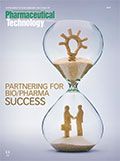Ensuring Quality Control in Vendor Relationships
A look at some best practices to ensure that quality control is maintained in the client–vendor relationship.
AUREMAR/STOCK.ADOBE.COM

Client–vendor relationships require a level of trust, open communication, and reliable deliverables. Pharmaceutical Technology spoke with Chris Mooney, senior quality assurance technical specialist at Fujifilm Diosynth Biotechnologies, a contract development and manufacturing organization (CDMO) specializing in cell culture, fermentation, and viral vectors; and Knut Niss, chief technology officer of Mustang Bio, a US-based clinical-stage biopharmaceutical specializing in chimeric-antigen-receptor-engineered T cell (CAR T) immunotherapies and gene therapies, to discuss current best practices that help ensure that quality control is maintained during the course of the client–vendor relationship. Mooney gives his views from the perspective of a CDMO dealing with materials suppliers, and Niss discusses his experience from the perspective of a biopharma company working with contract service providers as well as material suppliers.
Criteria selection
PharmTech: What criteria are sought after in a vendor/service provider?
Mooney (Fujifilm): Here at Fujifilm Diosynth Biotechnologies, we categorize our raw materials and components. The category of the material will determine the supplier requirements. The quality tools we primarily utilize are onsite supplier audits and audit questionnaires, plus supplier quality agreements. In order to become approved, suppliers must meet our acceptance criteria. Again, the material category will determine the frequency at which each supplier is re-evaluated.
Niss (Mustang Bio): The number one criterion for us in vendor selection is quality. We expect vendors to provide a quality system that is up to our own standards. While we are only in early stages of development, we realize that having a strong quality system is critical for an expedited path through development. We do not want to find ourselves in a situation where we have exciting clinical data with great promises for patients and then have to slow down development in order to develop appropriate quality management at the vendor. This includes the ability of the vendor to safely provide materials/services on time.
Practices in place
PharmTech: What systems or best-practice procedures are typically in place to ensure that there is quality control/quality oversight between vendors and their clients?
Niss (Mustang Bio): A key aspect is first to build a relationship between our quality assurance (QA) and the vendor’s QA organization. Single points of contact are critical here as those assure timely and proper communication between the organizations. Procedurally, a well-designed vendor questionnaire and ultimately an audit assure a good relationship. Generally, the theme should always be: trust is good, control is better!
Mooney (Fujifilm): All incoming materials used in cGMP manufacturing go through an evaluation, including inspections, or, in the case of raw materials, are tested. If an incoming material fails to meet our specifications, the material is rejected and a supplier complaint is initiated requesting the supplier to conduct an internal investigation.
In addition to incoming material evaluations, supplier change notifications are also monitored. It’s important that agreements are in place with your suppliers to provide change notifications. QA initially evaluates supplier change notifications. The significance of the change will determine if a cross-functional team is required to evaluate potential impact to product quality.
Keeping the line open
PharmTech: What tips do you have for keeping lines of communication open between vendor and client, and what is the impact of level of communication on the level of trust between vendor and client?
Mooney (Fujifilm): Typically, supplier and client communications occur through our supply chain and procurement departments. We continuously look for ways to improve communications. Several of our larger suppliers have come onsite to provide details about the products and services they provide. Whenever you have an opportunity to provide your suppliers with an overview of your company, take it. It is important that suppliers understand the materials they provide are used to manufacture drugs for human use.
Niss (Mustang Bio): The most important thing is to have single point of contact on both ends. If too many parties are involved, confusion and miscommunication set in, resulting in unnecessary delays. In this context, it is important that a backup is identified as well to assure an uninterrupted process in case the appointed contact is on vacation or otherwise out of the office.
PharmTech: How do quality assurance practices differ when dealing with one-off vendor relationships versus longterm vendor relationships?
Niss (Mustang Bio): For one-off suppliers, we generally apply the same rules. However, with long-term vendors, we like to establish a supply agreement that includes a quality agreement. With that, both sides know what to expect and can plan accordingly. Generally, we try to avoid one-offs as much as we can, unless there is a very compelling reason. For this, we follow ‘you get what you pay for’. In other words, cheap is not the only decision point, quality is.
Mooney (Fujifilm): No difference from a quality perspective. All suppliers providing us materials used in cGMP manufacturing must meet the same supplier approval requirements.
Article Details
Pharmaceutical Technology
Supplement: Partnering for Bio/Pharma Success
February 2019
Pages: s14–s16
Citation
When referring to this article, please cite it as F. Mirasol, “Ensuring Quality Control in Vendor Relationships," Pharmaceutical Technology Partnering for Bio/Pharma Success Supplement (February 2019).

Pharmaceutical Tariffs Are Imminent: How Industry is Bracing for Impact
April 16th 2025On April 14, 2025, the Trump Administration launched a national security-driven investigation into pharmaceuticals, a move that will likely result in tariffs being placed on pharmaceutical drugs, ingredients, and other components that are imported from outside of the United States.